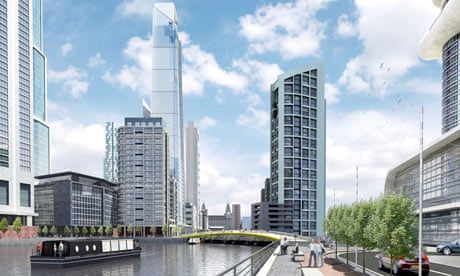Liverpool's world heritage status is under threat after the city council approved a multibillion-pound skyscraper scheme.
Despite vociferous objections from English Heritage and other conservation groups, the council's planning committee granted permission for Liverpool Waters, the UK's biggest planning application.
English Heritage's formal objection means the scheme will automatically be referred to the communities secretary, Eric Pickles, who will decide whether to hold a public inquiry or allow the project to go ahead.
In January, a delegation from Unesco concluded that the skyscraper proposal would result in "a serious loss of historic authenticity". The inspectors praised the "more or less symmetrical profile" of the city's waterfront, with the Three Graces – the Port of Liverpool and the Liver and Cunard buildings – at centre stage and historical docklands to the north complementing those to the south.
The Graces were "at the heart of the shipping and harbour operations during the height of [Liverpool's] glory, surrounded by dockyards and port structures," they said. The £5.5bn Peel Holdings development would "[relegate] the Three Graces to playing second violin … thereby losing an important visual and historical reference to the city's glorious past."
The council leader, Joe Anderson, said Liverpool was not a museum and investment was crucial to the city's future.
"Today's decision to grant planning permission for Liverpool Waters is one of the most significant and far-reaching made in Liverpool's recent history. It is a vote of confidence in a new beginning of a great city," he said.
"Liverpool has to grow and redevelop if we are to thrive and succeed in the future. We do not live in the past, we are not a museum. I care passionately about the future of Liverpool and the opportunities and life chances we give our children.
"Today's decision is for future generations. The new investment, businesses and employment opportunities Liverpool Waters will bring is the future for our city."
The Liverpool Waters plans feature 9,000 flats, hundreds of offices, hotels, bars and a cruise terminal, as well as the 55-storey Shanghai Tower and other high-rises. It involves two clusters of tall buildings, one near the city centre and a second further north.
English Heritage said it was disappointed by the decision and unhappy with the council's assessment which, it said, downplayed the adverse impacts of the development on Liverpool's heritage.
It said the scheme would "severely compromise" the setting of some of Liverpool's most significant historic buildings, risk damaging the archaeological remains of parts of the docks and unbalance the city's urban landscape.
Henry Owen-John, planning director for the north-west at English Heritage, said: "The decision is in no way a surprise because it has been presented very much as a choice between jobs and growth on one side and heritage on the other. We are really disappointed that it has been presented like that because we have always believed that it was possible to develop a scheme that maximised heritage and developed jobs and growth."

Comments (…)
Sign in or create your Guardian account to join the discussion